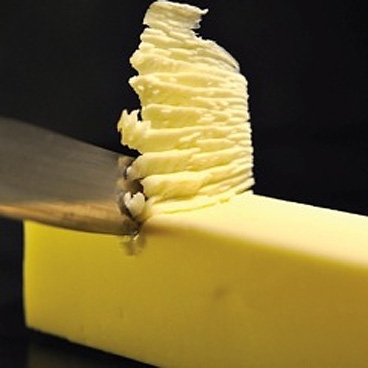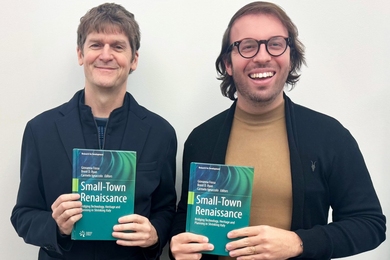It might not seem like scraping the top of a cold stick of butter with a knife could be a scientific test, but engineers at MIT say the process is very similar to the “scratch test,” perhaps the oldest known way to assess a material’s hardness and strength — or, in scientific language, its resistance to deformation.
Using the scraping of butter as a starting point, the MIT engineers launched a study to see if the age-old scratch test — used by researchers to gauge a material’s properties by indenting or scratching it with a tool — could be used to determine a material’s toughness, or how well it resists fracturing after a small crack has already formed. The answer: The scratch test does indeed measure crack resistance rather than strength, meaning that engineers now have a simple “new” test for assessing a material’s fracture properties.
“Fracture mechanics has not reached the same level of pervasiveness in most engineering practice as strength theories, and this is due to the fact that it is difficult to determine fracture properties of materials, from soft clay to hard concrete,” says Franz-Josef Ulm, the George Macomber Professor of Civil and Environmental Engineering (CEE) at MIT. “The test which we propose here is just this: a straightforward test for the engineering practice.”
In a Physical Review Letters paper that appeared online May 20, co-authors Ulm; Pedro Reis, the Esther and Harold E. Edgerton Assistant Professor of Civil and Environmental Engineering and Mechanical Engineering; and CEE graduate student Ange-Therese Akono — who is first author on the paper — describe their research and findings.
From wax to steel
The MIT engineers performed laboratory scratch tests on paraffin wax, which Reis says is similar to butter but more stable at room temperature, using theory and mathematics to pare the process down to its essential components. They then created a mathematical model of the entire “scratch” process, finding that the area of contact between the scratching implement and the test material is of primary importance in determining whether the scratch test is assessing strength or toughness.
When measuring a material’s strength, the force required to make a scratch always increases at the same rate as the contact area (width times depth) of the scratching tool. So, the researchers tweaked the scratch test to see if a wider implement would require more force than a narrow one; it did.
This video shows a laboratory experiment of a scratch test on paraffin wax.
Video: P. M. Reis and A.T. Akono
That seemingly minor change in one dimension gave them their answer: The scratch test is assessing a material’s fracture toughness, not its hardness or strength properties. It assesses the hardness and strength only in cases where the area of contact is so small that an indentation is made, rather than a true scratch. Now, knowing the width and depth of the scratch and the horizontal force, researchers can determine the fracture toughness of a material.
The MIT researchers confirmed their findings with additional tests on cement paste, limestone and steel.
A widespread test, explained
The idea of scratch tests dates back to antiquity: Ancient Greek and Roman writers referred to them in their work. In 1824, the German scientist Friedrich Mohs plotted the ability of one mineral to scratch another on a hierarchical comparison scale now called the Mohs scale of mineral hardness. Yet despite how long it has been in use, the exact physics of the scratch test have never before been defined.
“The authors of the paper make a widely used test finally understandable, and the measurements quantitative,” says Elisabeth Bouchaud, a physicist at the French technological research organization CEA who specializes in the study of material fracturing. “Because scratching tests are easier to carry out than clean-fracture mechanics tests, it is very useful, for practical applications, to know that they can provide a reliable measurement of fracture toughness. Furthermore, to analyze fracture at small scales is increasingly important, if only in the field of heterogeneous materials.”
“You might think that fracture, or how things break, is an old field of study,” Reis says. “But it’s relatively new compared to the tests of a material’s hardness. Now, using the very old method of the scratch test, we have a relatively simple new means for measuring a material’s toughness.”
“The scalability of scratching for different probes and depths will open new venues for the miniaturization of the technique, which will help us understand fracture properties of materials at very small scales,” Ulm adds. “We also know — finally — that it takes less effort to make a narrow, deep cut in cold butter than a wide one. And that is science we can use at the dinner table.”
The centuries-old test for strength actually determines fracture resistance of materials.
Publication Date:

Credits:
Photo: P. M. Reis and I. Ariceta





